
Discrete (aka finite aka concrete) mathematics
| Tags | Math |
|---|---|
| Created | |
| Updated |
What is discrete mathematics?
It is also known as Mathematics for computer science. Sometimes finite mathematics, or concrete mathematics.
Discrete mathematics is the study of numerable sets, it is distinct from others. – such as integers, graphs, and statements in logic.
- Numerable. From Latin numerābilis.
- (mathematics) In one to one correspondence with the set of natural integers.
https://www.merriam-webster.com/dictionary/numerable
https://www.dictionary.com/browse/numerable?s=t
Discrete. "separate, distinct from others," late 14c., from Old French discret, discre, and directly from Latin discretus "separated;" see discreet. Related: Discretely; discreteness. https://www.etymonline.com/word/discrete
Resources
Foundations
| Name | Why? | Topics | Authors | Last edition |
|---|---|---|---|---|
| Discrete mathematics | Most topics. Several examples. Coding. | Richard Johnsonbaugh | ||
| Mathematics for Computer Science - Textbook | The clearest | Albert R MeyerEric LehmanF Thomson Leighton | ||
| Discrete Mathematics and Its Applications | applications | Kenneth H. Rosen | ||
| Discrete and combinatorial mathematicas | Ralph P. Grimaldi | |||
| Mathematics for Computer Science (6.042J) - Course | Adam ChlipalaAlbert Meyer | |||
| Concrete Mathematics (Second edition) | Discrete calculusDiscrete probabilityNumber Theory | Donald E. KnuthOren PatashnikRonald L. Graham | ||
| CS103: Mathematical Foundations of Computing | ||||
| 1. Nilsson, N.J.: "Artificial Intelligence, a new synthesis", Ed. Morgan Kaufmann Publishers, 1998 | ||||
| Untitled |
Requisites
- Minimum formal math.
Nice to have
- Calculus
- Coding skills
Foundations topics
Set theory
Sets
Mathematical logic
Combinatorics
Combinations
Permutations
Partitions
Graph theory
Graphs
Networks
Number theory
Integers
Transcendental numbers
Diophantine approximation
p-adic analytics
Function fields
Algebraic structures
Boolean algebra
Relational algebra
Algebraic coding theory
Formal languages
Discretization
Numerical analysis
Applications
Discrete calculus
Sequences
Recurrence relation
Discrete probability
Discrete geometry
Discrete collections
Operations research
Linear programming
Optimization
Queuing theory
Scheduling theory
Network theory
Continous-time Markov process
Game theory
Decision theory
Utility theory
Social choice theory
Game theory
Topology
Combinatorial topology
Topological graph theory
Information theory
Coding theory
Analog coding
Analog signals
Analog encryption
Theoretical computer science
Automata theory
Formal languages
Computational geometry
Sets
Definitions
Level 1.
Collection. A group of objects of one type that have been collected by one person or in one place. Oxford dictionary.
Object. The objects are sometimes referred to as elements or members. Elements are unique.
Level 2.
Group. A number of people or things that are located close together or are considered or classed together. Oxford dictionary.
Level 3.
Number - The content of a statement of number is an assertion about a concept. [source: The Foundations of Arithmetic, §55, Engl.transl. page 67].
How to use sets?
.
Finite sets. E.g.
Either infinite or large finite sets. E.g.
Number sets

Worked examples
Show that
By def.
By inspection
,
since every element of is an element of .
Show that
By def.
Let , because is closed under the operation of multiplication. since .
Show that
By def.
but iff , so the consequent always is , hence .
Show that ,
By def.
, so .
In a group of students, each student is taking a mathematics course or a computer science course or both. One-fifth of those taking a mathematics course are also taking a computer science course, and one-eighth of those taking a computer science course are also taking a mathematics course. Are more than one-third of the students taking a mathematics course?
,
We know , (1), but
(2)
By 1
We’ll substitute in (2)
Let C be a circle and let D be the set of all diameters of C. What is ∩ D? (Here, by “diameter” we mean a line segment through the center of the circle with its endpoints on the circumference of the circle.)
If
then
Let P denote the set of integers greater than 1 (). For i ≥ 2, define . Describe .
describes composite numbers since describes multiples, so
Mathematical logic
Key ideas
Logic is the basis of all reasoning.
Classical Propositional Logical
A proposition is a communicated declarative sentence that is either true or false, but not both. Remember structure no content.
- Don't use "preposition" as synonymous with "proposition". A preposition is a word such as 'by', 'for', 'into', or 'with' which usually has a noun group as its object. Collins.
- Other views of propositions. A proposition is the meaning expressed by statements.
- Some people use statements and propositions interchangeably.
The following statements are propositions
-
-
- P=NP This is either true or false (but not both), but you don't know.
- for all , then
- Sun leaves tomorrow.
-
- She loves him.
- Whenever Juney barks, Ralph gets mad.
💡Actually, whether sentence is a preposition while the sentence matches the definition.
Moreover, the definition excludes statements such as
- Read 'Cogito ergo sum' in Discourse on the Method. (command)
- Let's go to the beach tomorrow. (proposal)
- God'll help you! (exclamation)
- (question)
- (indeterminate declarative sentence). It's a predicate.
- if , then
- (indeterminate declarative sentence)
- This sentence is false. A paradox is not a statement.
You gonna use variables to represent prepositions, thus as you use letters in algebra. e.g.
The Connectives of Propositional Logic. In short, Logical formulas
Definition.
Let and be propositions.
| Name | Denotation | Meaning |
| Conjunction | p && q | p and q |
| Disjunction | p || q | p or q. Inclusive-or |
| Negation | !p | not p |
Worked examples
- Write the negation of the proposition.
Ten heads were obtained when you flip 10 times a coin.
By Morgan Law
In plain English, the following propositions are equivalent
Ten heads were not obtained.
Some flipped coins were not head.
Some flipped coins were tail.
At least one flipped coin was tail.
Some heads were obtained when you flip 10 times a coin.
By Morgan Law
In plain English, the following propositions are equivalent
At least one head was not obtained.
Some heads were not obtained.
All the flipped coins were not heads.
No flipped coin was head.
All the flipped coins were tail.
Some heads and some tails were obtained.
The above proposition is equivalent to
Because the flipped coins are either head or tail.
Because the coin is either head or tail, but not both.
So by complement law
The negation of the proposition is
Since 0/1 laws.
At least one was obtained.
No head was obtained.
All the flipped coins were tails.
For some positive integer ,
No positive integer ,
All positive integers ,
Every even integer greater than 4 is the sum of two primes.
Every even integer greater than 4 is not the sum of two primes.
At least one integer greater than 4 is not the sum of two primes.
- Determine whether each is true or false.
and
and are not the case.
or and are not the case.
- Formulate the symbol expression in words using
Lee doesn’t take computer science.
Lee takes computer science or no mathematics.
Lee takes computer science and mathematics.
Lee takes computer science, but no mathematics.
Lee takes neither computer science nor mathematics.
- Formulate the symbolic expression in words using .
Today is Monday or raining.
Today is neither Monday nor raining, but it is hot.
Today is Monday and it’s raining or hot, but it’s hot, raining, or Monday.
At one time, the following ordinance was in effect in Naperville, Illinois: “It shall be unlawful for any person to keep more than three [3] dogs and three [3] cats upon his property within the city.” Was Charles Marko, who owned five dogs and no cats, in violation of the ordinance? Explain. https://www.chicagotribune.com/news/ct-xpm-1990-10-12-9003250777-story.html
Yes.
Informally, if you have five dogs, then you’re keeping more than three dogs.
Formally
Maybe Charles Marko thought government counts in total such that
but his ordinance interpretation fails; the government doesn’t say it explicitly, and we don’t assume anything from the text.
Although attorney argues that is possible to change to , if you follow connectives of propositional strictly; it is a mistake.
6. Lógica computacional, Enrique Paniagua Arís et al., Ed. Thomson, 2003.
7. Elementos de lógica formal, Calixto Badesa et al., Ed. Ariel, 2003.
Truth tables
- Created by Charles Sanders Peirce. Popularized by Ludwig Wittgenstein in his Tractatus Logico-Philosophicus.
When you wish to provide a conclusion (or proof in mathematics), you must use chain statements throughout logical consequences (or connectives, methods, and pieces of evidence) from a base set of previous results – such as axioms, theorems, and definitions.
value judgment
Conditional propositions and logical equivalence
If and are propositions, the proposition
is called a conditional proposition and is denoted .
| p | q | | Comments |
| T | T | T | You must prove this by assuming the antecedent. |
| T | F | F | You don’t prove this since the conclusion is false. |
| F | T | T | True by default or vacuously true, so you don’t prove this. |
| F | F | T | True by default or vacuously true, so you don’t prove this. |
- Sufficient condition. If A then B. B whenever the occurrence of A is all that is needed for the occurrence of B. A guarantees B, but B might be achieved in other ways.
If X is a cat, then X is an animal.
- Necessary condition. A cannot occur without the occurrence of B, but B doesn’t guarantee A.
If not B then not A.
If X is not an animal, then X is not a cat.
If X is a cat, then X is an animal.
Si P, entonces Q. P: X es Y. Q: Z es W.
Si X es Y, entonces Z es W.
P es una condicion suficiente para que ocurra Q. Q ocurre porque P. P no es una condicion necesaria para que ocurra Q. Q puede ocurrir sin necesidad de que ocurra P. P garantiza Q, pero Q puede lograrse de otras maneras. Siempre que ocurra P, pasara Q. La implicacion no es un argumento, sino su sintesis. Es el fundamento para las inferencias.
Analisis de la tabla de verdad: True => True True True => False False Si sabemos que (P=>Q es falso) entonces P es verdaero y Q es Falso. True =>
Si no Q, no P. Si no ocurre Q es una condicion suficiente para que no haya pasado P.
no P o Q.
A common mistake is no P ⇒ no Q, it is a mistake because Q can occur if P doesn’t happen.
Worked examples
Restate each proposition in the form of a conditional proposition.
Joey will pass the discrete mathematics exam if he studies hard.
p: Joey will pass the discrete mathematics exam
q: He studies hard.
Rosa may graduate if she has 160 quarter-hours of credit.
p: Rosa may graduate.
q: she has 160 quarter-hours of credit.
A necessary condition for Fernando to buy a computer is that he obtain $2000.
p: Fernando to buy a computer.
q: He obtains $2000.
A necessary condition for is .
not q then not p
A sufficient condition for Katrina to take the algorithms course is that she pass discrete mathematics.
p: Katrina to take the algorithms course.
q: She passes discrete mathematics.
A sufficient condition for is .
Getting that job requires knowing someone who knows the boss.
p: Getting that job.
q: Knowing someone who knows the boss.
A necessary condition for getting a job is knowing someone who knows the boss.
A necessary condition for p is q.
You can go to the Super Bowl unless you can’t afford the ticket.
p: You can go to the Super Bowl.
q: You can afford the ticket.
p unless not q
p except on the condition that not q
A necessary condition for is not (not ).
A necessary condition for is q.
You may inspect the aircraft only if you have the proper security clearance.
p: You may inspect the aircraft.
q: You have the proper security clearance.
A necessary condition for p is q.
if not q, not p.
if p, then q.
When better cars are built, Buick will build them.
p: Better cars are built
q: Buick will build them
If p then q
https://www.youtube.com/watch?v=_rKewYe3INU&ab_channel=OsbornTramain
The audience will go to sleep if the chairperson gives the lecture.
p: The audience will go to sleep.
q: The chairperson gives the lecture.
The program is readable only if it is well structured.
p: The program is readable.
q: It is well structured.
A necessary condition for the switch to not be turned properly is that the light is not on.
p: The switch is turned properly.
q: The light is on.
A necessary condition for not p is that not q.
if q then p.
Represent the given proposition symbolically
Argument
Rules of Inference
Worked examples
Formulate the following arguments symbolically and determine whether each is valid.
Let
p: I study hard.
q: I get A’s.
r: I get rich.
If I study hard, then I get A’s. I study hard. Therefore, I get A’s.
It’s a valid argument because the argument uses the modus ponens.
If I study hard, then I get A’s. If I don’t get rich, then I don’t get A’s. Therefore, I get rich.
From contrapositive, we may use Hypothetical syllogism to conclude . Thus the conclusion follows from the hypotheses and the argument is valid.
I study hard if and only if I get rich. I get rich. Therefore, I study hard.
Argument (I)
By Disjunctive syllogism
By Modus ponens, (1) is valid
If I study hard or I get rich, then I get A’s. I Get A’s. Therefore, If I don’t study hard, then I get rich.
The argument becomes
It’s invalid because is equivalent , and it’s not the conclusion.
If I study hard, then I get A’s or I get rich. I don’t get A’s and I don’t get rich. Therefore, I don’t study hard.
It’s a valid argument since modus tollens application
Notes
https://en.wikipedia.org/wiki/List_of_rules_of_inference
https://calcworkshop.com/logic/rules-inference/
http://logic.stanford.edu/intrologic/glossary/rule_of_inference.html
http://intrologic.stanford.edu/chapters/chapter_04.html
https://www.cs.sfu.ca/~ggbaker/zju/math/inference.html
Quantifiers
A predicate can be understood as a proposition whose truth depends on the value of one or more variables.
Nested Quantifiers
Proofs
Mathematical systems and the Axiomatic method
What is suitable proof?
Direct proofs
Proof by contradiction
Proofs of equivalence
Problem Set
Proofs
What is the proof?
Proof. A finite sequence of statements (called well-formed formulas in the case of a formal language), each of which is a previous result -axiom, an assumption, experiments, or theorems- in the sequence by a rule of inference.
Axiom. Simple postulate or assumption based on a priori knowledge and free contradictions.
Theorems. Important true statements.
Lemma. Preliminary statements.
Corollary. Statements that follow a few logical steps from the theorem.
https://mathoverflow.net/questions/18352/theorem-versus-proposition
Good proofs
- State your game plan.
- Keep a linear flow.
- A proof is an essay, not a calculation.
- Avoid excessive symbolism.
- Revise and simplify.
- Introduce notation thoughtfully.
- Structure long proofs.
- Be wary of the “obvious.”
- Finish.
Notes
Mathematical Writing by Knuth, Larrabee, and Roberts, https://jmlr.csail.mit.edu/reviewing-papers/knuth_mathematical_writing.pdf
Guide to Proofs, Stanford https://web.stanford.edu/class/archive/cs/cs103/cs103.1156/handouts/070 Guide to Proofs.pdf
Proofwriting Checklist, Stanford https://web.stanford.edu/class/cs103/proofwriting_checklist
Some Remarks on Writing Mathematical Proofs by John M. Lee
https://www.youtube.com/watch?v=B0acu5nhG0w&ab_channel=StanfordOnline
https://math.stackexchange.com/questions/424854/1-0-by-integration-by-parts-of-tanx/424855#424855
 https://math.stackexchange.com/questions/1024280/most-ambiguous-and-inconsistent-phrases-and-notations-in-maths
https://math.stackexchange.com/questions/1024280/most-ambiguous-and-inconsistent-phrases-and-notations-in-maths
Methods
Direct proof
Worked examples
Prove that for all integers m and n, if m and n are even, then m + n is even.
Let such that is even and is even, by even definition we know
and where .
So, is even since .
Proof by perfect induction o Proof by exhaustion
Proof of a Boolean theorem through perfect induction.
Simple induction
We know by Modus Ponens:
The principle of induction says
use when but the same to simple if always is true then is always true.
Strong induction
https://www.youtube.com/watch?v=9w20J4j5-0Y&ab_channel=AtticPhilosophy
Worked example.
Therefore
Because ,
Our theorem is false since
our argument is always false.
Our argument is valid, but it is always false.
As
Our argument is valid and it happen be always true.
https://web.stanford.edu/~dntse/classes/cs70_fall09/cs70-2_notes3.pdf
https://www.purplemath.com/modules/inductn2.htm
Boolean Algebra
Proof of a Boolean theorem through perfect induction
https://www.youtube.com/watch?v=z7QCT8cgsR4&ab_channel=FrankStajanoExplains
Zermelo-Fraenkel Axioms
Our Axioms
Mathematical data types
Counting
Sums and Asymptotics
Cardinality Rules
The Bijection Rule
Bijection := one-to-one correspondence
Each element of one set is paired with exactly one element of the other set, and each element of the other set is paired with exactly one element of the first set.
What does it mean to write |A| = n?
It means that there is a bijection f : A → {1, . . . , n}
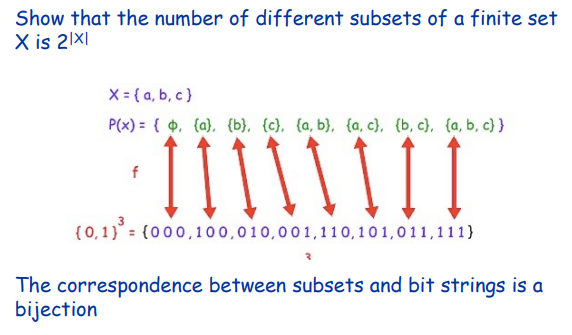
MIT OpenCourseWare. 2016. 3.3.3 Counting with Bijections: Video. YouTube. Retrieved May 25, 2021 from https://www.youtube.com/watch?v=n0lce1dMAh8
The Bijection Rule or Equinumerosity
Let S and T be two finite sets. If there exists one-to-one correspondence (or bijection) between them, from S to T, if and only if i.e. S and T have the same number of elements. This is taken as the definition.
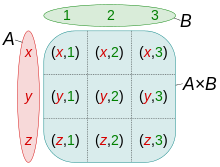
https://www.cs.colostate.edu/~cs220/summer19/slides/16_bijection_rule.pdf
Counting Sequences
Multiplication Principle or Product Rule
called Cartesian product.
Thus, if are finite sets, then
.png)
For example, if and
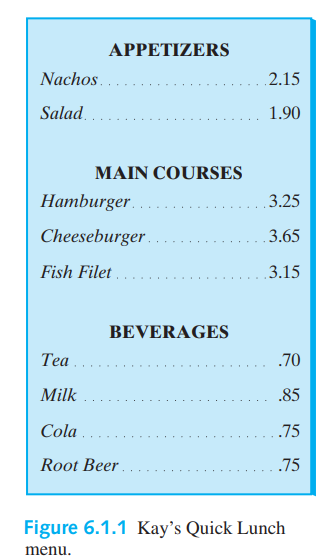
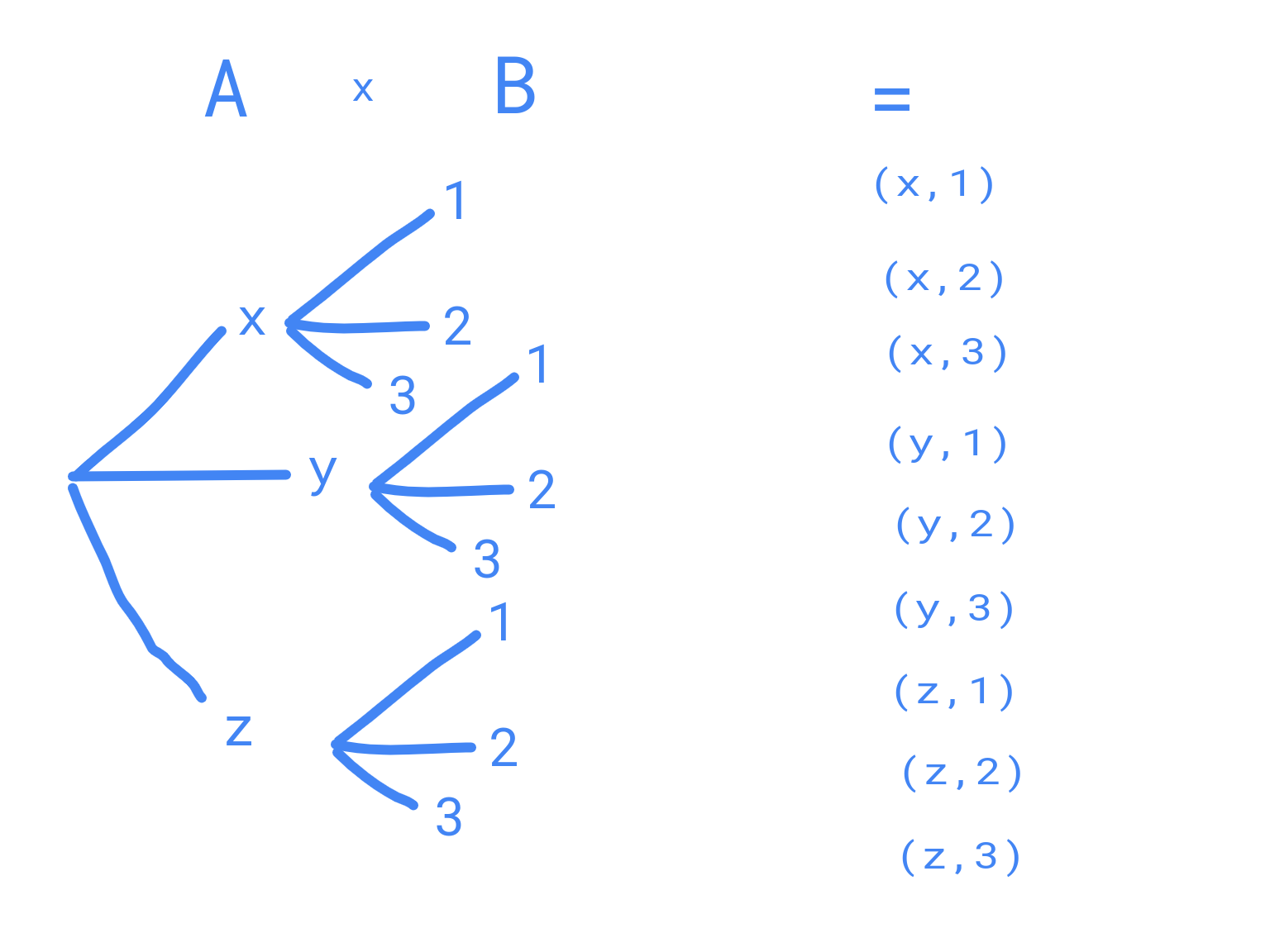
Key ideas
- When we're counting since cardinality is more important than the set . We will ignore writing it.
- No decision might be part b of the set. When your problem says about optional something.
- If repetitions are allowed,
- If repetitions are not allowed, You'd remove the last used element such that
-
Product Rule Worked examples
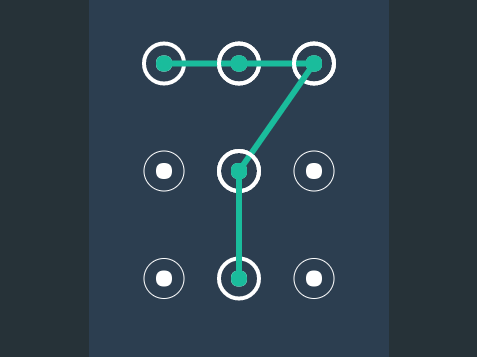
How many dinners at Kay’s Quick Lunch (Figure 6.1.1) consist of one appetizer and one beverage?
,
How many dinners at Kay’s Quick Lunch (Figure 6.1.1) consist of an optional appetizer, one main course, and an optional beverage?
How many dinners at Kay’s Quick Lunch (Figure 6.1.1) consist of one appetizer, one main course, and an optional beverage?
A man has eight shirts, four pairs of pants, and five pairs of shoes. How many different outfits are possible?
, and,
Two dice are rolled, one blue and one red. How many outcomes are possible?
,
The Braille system of representing characters was developed early in the nineteenth century by Louis Braille. The characters, used by the blind, consist of raised dots. The positions for the dots are selected from two vertical columns of three dots each. At least one raised dot must be present. How many distinct Braille characters are possible?
are Braille characters possibles.
The options available on a particular model of a car are five interior colors, six exterior colors, two types of seats, three types of engines, and three types of radios. How many different possibilities are available to the consumer?
How many different car license plates can be constructed if the licenses contain three letters followed by two digits if repetitions are allowed? if repetitions are not allowed?
If repetitions are allowed, then
If repetitions are not allowed, then
How many 7-digit phone numbers are possible, assuming that the first digit can’t be a 0 or a 1?
Re-solve the previous problem, except now assume also that the phone number is not allowed to start with 911
Why the number of ways to choose 5 people out of 10 is greater than the number of ways to choose 6 people out of 10?
Why the number of ways to break 10 people into 2 teams of 5 is less than the number of ways to break 10 people into a team of 6 and a team of 4?
Exercises 10–12 ask about strings of length 5 formed using the letters ABCDEFG without repetitions.
10. How many strings begin with the letter F and end with the letter A?
11. How many strings begin with the letter F and do not end with EB in that order?
12. How many strings contain CEG together in that order?
But, a sequence n and sub-sequence r together can simplify as .
sub-sequence,
, where CEG can be 3 distinct positions.
But, We'll convert to size sequence, such that
sub-sequence,
, where CEG can be 3 distinct positions.
Thus,
Two chess players, A and B, are going to play 7 games. Each game has three possible outcomes: a win for A (which is a loss for B), a draw (tie), and a loss for A (which is a win for B). A win is worth 1 point, a draw is worth 0.5 points, and a loss is worth 0 points.
How many possible outcomes for the individual games are there, such that overall player A ends up with 3 wins, 2 draws, and 2 losses?
How many possible outcomes for the individual games are there, such that A ends up with 4 points and B ends up with 3 points?
Now assume that they are playing a best-of-7 match, where the match will end when either player has 4 points or when 7 games have been played, whichever is first. For example, if after 6 games the score is 4 to 2 in favor of A, then A wins the match and they don't play a 7th game. How many possible outcomes for the individual games are there, such that the match lasts for 7 games and A wins by a score of 4 to 3?
267
Addition Principle or Sum Rule
If are disjoint sets, then:
Inclusion–exclusion principle
If and are finite sets, then
The k-to-1 rule or division rule
If B is a finite set and f : A → B maps precisely k items of A to every item of B, then A has k times as many items as B.
https://dspace.mit.edu/bitstream/handle/1721.1/70477/6-042j-fall-2002/contents/readings/ln9.pdf
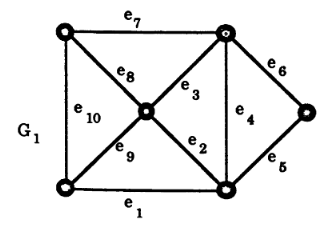
The division rule is a common way to ignore “unimportant” differences when you are counting things. You can count distinct objects, and then use the division rule to “merge” the ones that are not significantly different.
Permutations
A permutation of n things taken r at a time, written P(n,r), is an arrangement in a row of r things, taken from a set of n distinct things. Order matters.
In your problem,
Example: How many permutations of the letters ABCDEF contain the letters DEF together in anyorder?
Counting Subsets or combinations
A combination of n things taken r at a time, written C(n,r) or n r (“n choose r”) is any subset of r things from n things. Order makes no difference.
In your problem,
The key points to remember in this section are that a permutation takes order into account and a combination does not take order into account. Thus, a key to solving counting problems is to determine whether we are counting ordered or unordered items.
Combinatorial Proofs
Vandermonde's identity
The Binomial Theorem
Pascal’s Triangle Identity
Worked examples
How many ways are there to split a dozen people into 3 teams, where one team has 2 people, and the other two teams have 5 people each?
For example, or . First one references to itself, the second one references to teams by that group by 2.
How many ways are there to split a dozen people into 3 teams, where each team has 4 people?
For example. First one eferences to teams by that group by 3.
The Pigeonhole Principle
TIP. Bash. Brace expansion.
echo {1..3}{1..2}{5..10} | wc -w # 36
echo {1..3}{1..2} # 11 12 21 22 31 32https://wiki.bash-hackers.org/syntax/expansion/brace
Generating Functions
Diophantine equations
https://www.hackmath.net/en/calculator/integer-diophantine-equations-solver
Finite calculus
Discrete logarithm problems
https://www.youtube.com/watch?v=cI5lkif-V1c&ab_channel=ALEXonScience
Recurrences relations, sequences, and subsequences, or difference equations
Worked examples
Define a sequence iteratively by and
https://citeseerx.ist.psu.edu/viewdoc/download?doi=10.1.1.39.9228&rep=rep1&type=pdf
https://www.geogebra.org/calculator/j6ncgwpp
Let a recurrences relation $$ and . Find its closed form.
Note
https://web.math.utk.edu/~cplaut/docs/analysis.pdf
https://wp.kntu.ac.ir/hrahmanei/Adv-Control-Books/Difference-Equations-Axler.pdf
http://mitran-lab.amath.unc.edu/courses/MATH564/biblio/text/02.pdf
https://people.math.aau.dk/~matarne/11-imat/notes2011a.pdfte.edu/math312/Spring1999/iterate.html
An Introduction to Difference Equations (Undergraduate Texts in Mathematics)
Introduction to Difference Equations 978-0486650845
https://www.cimt.org.uk/projects/mepres/alevel/discrete_ch14.pdf
https://www.rand.org/content/dam/rand/pubs/reports/2006/R374.pdf
https://people.math.umass.edu/~lr7q/ps_files/teaching/math456/Chapter3.pdf
Graph theory
Definiciones
Grafo o red -Graph-
, donde V son los vértices y E las aristas.
Loop
Una arista conectada a un vértice a sí misma.
Directed
Walk
Cycle
Circuit
Open walk
Closed walk
Definiciones
| Concepto | Def. | Ejemplo | Representación | Observaciones |
| Graph, Network | G = (V, E), donde V son los vertices y E las aristas. | |||
| Loop | Una arista conectada a un vertice a si mismo. | |||
| Directed | Cada arista tiene una direccion. | |||
| Walk | Una sequencia | |||
| Cycle | ||||
| Circuit | ||||
| Open walk | Walk donde el primer y el ultimo vertice son distintos. | |||
| Closed walk | Walk donde el primer y el ultimo vertice son iguales. | |||
| Trail | Un walk abierto con distintas aristas. | |||
| Path | Un walk abierto con distintos vertices y aristas. Todos los path son trials. | |||
| Euler Trail | Un trial que incluye todas las aristas del grafo, esto es, en el trial cada arista aparece exactamente una sola vez. | |||
| Connected | Un grafo donde existe un path entre cualquier par de de vertices. | |||
| Tour | Closed Walk que incluye todos las aristas al menos una vez. | |||
| Euler Tour o Eulerian Circuit | Tour donde cada arista es incluida una unica vez. Asi, es un Euler Trial cerrado. Otra def: Un tour de Euler de un grafo dirigido fuertemente conectado G = (V, E) es un ciclo que atraviesa cada arista de G exactamente una vez, aunque podría visitar los vértices en más de una ocasión. | |||
| Eulerian | Eulerian es un grafo que tiene un Euler Tour | |||
| Component | Un maximo conectado subgrafo. | |||
| Tree | Un conectado subgrafo. | |||
| Free tree | Un arbol con ninguna raiz. | |||
| DAG | Grafo aciclico dirigido. | |||
| Eulerian -Tour de Euler, ciclo euleriano, camino de Euler- | Un tour de Euler de un grafo dirigido fuertemente conectado G = (V, E) es un ciclo que atraviesa cada arista de G exactamente una vez, aunque podría visitar los vértices en más de una ocasión. | |||
| Hamiltonian | Grafo con un ciclo visitando cada vertice una vez. | |||
| Cut -corte- | Conjunto de vertices donde cada remoción incrementa el numero de componentes. | |||
| Cut-set | El minimo corte. | |||
| Cut-edge | El tamano de un corte. | |||
| k-Connected | Un grafo conectado con la remoción de k-1 vertices. | |||
| k-Tough | we have | |||
| k-Regular | Un grafo donde todos los vertices tienen grado k. | |||
| k-Factor | Un k-regular esparza un subgrafo. | |||
| Matching | Un conjunto de aristas, no pares que no tienen adjuntos. | |||
| Clique | Un conjunto de vertices que son todos adjuntos. | |||
| Ind. set | Un conjunto de vertices donde ninguno es adjunto. | |||
| Vertex cover | Un conjunto de vertices el cual cubre todos las aristas. | |||
| Planar graph | Un grafo el cual esta embebido en un plano. | |||
| Plane graph | El embemiento de un planar graph. | |||
| Order | Numero de vertices en el grafo. | |||
| Size | Numero de aristas en el grafo. |
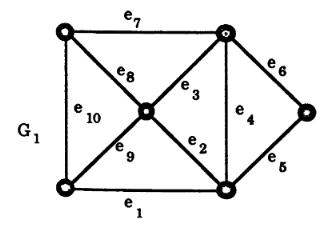

Notación
| Español | Rep. matemática | Ejemplo |
| Grafo o red | | |
| Nodo o vértice -vertex- | | |
| Conjunto de aristas, arcos o enlace -edge- | , | |
| Conjunto de vértices | , | |
| Cantidad de componentes | | |
| Subgrafo inducido | | |
| Grado de un vértice | | |
| Máximo grado del grafo | | |
| Menor grado del grafo | | |
| Número cromático | | |
| Número cromático de aristas | | |
| Complemento del grafo | | |
| Grafo completo | | |
| Grafo completo bipartito | | |
| Número de Ramsey | | |
| Grado de entrada | | |
| Grado de salida | |
Notas
http://www.uop.edu.pk/ocontents/Euler Tours.pdf
If you want to represent a graph use Graphviz and its dot language.
Para representar grafos usa Graphviz y su dot languaje, una version online esta disponible o https://edotor.net/
Frank Harary. Graph Theory. Addison-Wesley, 1969.
Gross, J. L., & Yellen, J. (2003). Handbook of graph theory. CRC press.
Operator precedence
Operator precedence is about associations, no evaluations. You can evaluate how you want, but following operator precedence. When operators have the same precedence, you must associate left to right.
Example:
What do you think about below sentence? Will be either i=1 or i=0?
let i = 0;
i == 0 || ((i = Math.sqrt(i+1)) == 1 && ++i == 1);
// What will be i's value, i = 0 or i = 1?Even though &&, (), Math.sqrt() have higher precedence, will be 0 since JavaScript evaluates left hand side first and because T || x = T, it doesn’t evaluate right hand side.
